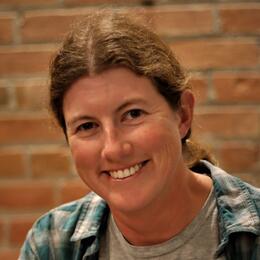Another entry in Abby’s Birdbrained Summer. Abby, the summer communication intern for the Coast Office of Audubon North Carolina, is visiting sites with Audubon’s field staff and our community of volunteers. After she goes into the field, she’ll post blogs detailing her experiences.
This week, the coastal office of Audubon North Carolina concentrated on community outreach to children. Marlene, the volunteer coordinator for Wrightsville Beach, has realized that getting kids involved with the birds is both educational and exciting. Whether in a group of five or forty, Marlene said the kids “loved using the scope and binoculars” to watch the birds and their chicks.
The shorebird posting on the south end of Wrightsville is perfect for first-time bird watchers. When we arrived, hundreds of Least Terns and Black Skimmers were visibly incubating eggs or flying to the water to hunt for fish. I visited the with a group of five homeschoolers ranging from eighteen months to seven years old, but a group of forty from the City of Wilmington’s Summer Camp came later in the week.
First, Marlene taught the kids how shorebirds build their nests by forming shallow indentations in the sand. Marlene said that the summer camp group was “surprised to learn that birds didn’t bury their eggs,” because they had recently learned about turtles’ nesting habits. To show the kids what a Least Tern looked like, we used a stuffed toy and a real Least Tern egg which was non-viable preserved for education. The kids then built their own nests in the sand; some even decorated their nests with feathers or shells, like the birds do. Marlene even had some plastic eggs and cottonball chicks to put in their nests, and explained how well the birds use camouflage to hide their eggs and chicks. When the kids were done constructing their nests, they had a colony, like the birds.
When I was with the homeschool group, we saw a group of Least Terns launch into flight, and one of the kids asked what was going on. Marlene explained that the terns nest in a colony so they can communally chase away predators and protect their eggs. She had a volunteer pretend to be a crow stealing eggs, and the group chased him away from their nests. “I did not know that a bird could steal another bird’s eggs. Well, a hawk, but not a crow!” remarked Asa, who visited with the homeschool group.
Then we moved on to show the kids close-up images of the birds through the scope and binoculars. The chicks blended in so well with the surrounding landscape that it was hard to see them at first, but the kids quickly adapted and were incredibly excited to see the fluffy babies. Even in a large group, everyone got several chances to see the chicks interacting with their parents. Sandra, a parent of visiting children, commented “It was awesome, it was educational, and the kids loved it.”
With help from bio tech Zach Gilstrap and volunteers Katharine and Michelle Frazier and Kathy Hannah, Marlene introduces 45 day campers to beach-nesting birds. By Kathy Hannah.
The volunteers loved it too. "I was very impressed by the manners, enthusiasm, curiosity, adult leadership skills, knowledge, cooperation, kindness and energy of the students and teachers. I enjoyed watching them find chicks using the scopes and binoculars," said volunteer Kathy Hannah.
Volunteer Michelle Frazier said "I really enjoyed sharing the colony with such an enthusiastic bunch of kids—they were so observant and curious, and asked some great questions. By the end of the trip, they were handling the scopes and binoculars with ease and spotting those well-camouflaged chicks like pros!"
If you are interested in visiting the nesting colony, by yourself or with a group, contact Marlene at marlene.eader@gmail.com.




